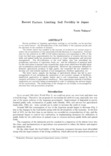Recent Factors Limiting Soil Fertility in Japan
Tropical agriculture research series : proceedings of a symposium on tropical agriculture researches
| ISSN | 03889386 |
|---|---|
| 書誌レコードID(総合目録DB) | AA00870529 |

本文フルテキスト
tars24-_79-89.pdf1.9 MB
Recent problems of Japanese agriculture relating to soil fertility can be ascribed to two main factors: the diversification of the food habits of the Japanese people and the decrease in the numbers of farmers.
The former factor has resulted in the increase of production of various crops to reduce the accumulation of rice associated with the decrease in consumption. National plan for the utilization in 1990 of 0.83 million hectares (corresponding to 30% of the total rice field area, approximately) for the implementation of rotation between rice fields and upland fields has promoted research on water management and plowsole management. The diversification of the food habits, also, has stimulated the greenhouse cultivation of vegetables, fruits, etc. and the utilization of marginal land for the cultivation of special crops, in particular, slope areas, which have brought about salt accumulation and soil erosion, respectively. Moreover, the consumers' demand for domestic agricultural products of high quality has compelled the soil scientists to develop new and suitable methods of soil management, fertilizer application, etc.
The latter factor, namely the shortage of agricultural labour, has led to poor management of soil, including the application of an excessive amount of fertilizers, insufficient application of organic matter and to soil compactness caused by the
intensive utilization of agricultural machinery. More appropriate methods of fertilizer application are currently being recommended in order to minimize the adverse impact on the environment. The monitoring of the changes in soil fertility is encouraged by national laws and government programs.
The former factor has resulted in the increase of production of various crops to reduce the accumulation of rice associated with the decrease in consumption. National plan for the utilization in 1990 of 0.83 million hectares (corresponding to 30% of the total rice field area, approximately) for the implementation of rotation between rice fields and upland fields has promoted research on water management and plowsole management. The diversification of the food habits, also, has stimulated the greenhouse cultivation of vegetables, fruits, etc. and the utilization of marginal land for the cultivation of special crops, in particular, slope areas, which have brought about salt accumulation and soil erosion, respectively. Moreover, the consumers' demand for domestic agricultural products of high quality has compelled the soil scientists to develop new and suitable methods of soil management, fertilizer application, etc.
The latter factor, namely the shortage of agricultural labour, has led to poor management of soil, including the application of an excessive amount of fertilizers, insufficient application of organic matter and to soil compactness caused by the
intensive utilization of agricultural machinery. More appropriate methods of fertilizer application are currently being recommended in order to minimize the adverse impact on the environment. The monitoring of the changes in soil fertility is encouraged by national laws and government programs.
| 刊行年月日 | |
|---|---|
| 作成者 | Norio Nakaya |
| 公開者 | Japan International Research Center for Agricultural Sciences |
| 巻 | 24 |
| 開始ページ | 79 |
| 終了ページ | 89 |
| 言語 | eng |
